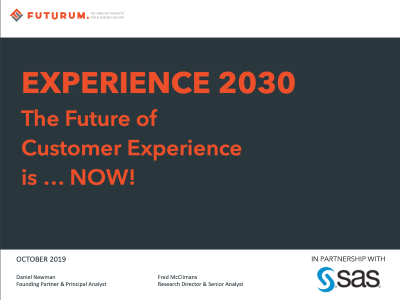Sometimes, Bad Customer Data Is Worse than None
February 10, 2020To remain competitive in today’s data-driven world, sales success is highly dependent on a superior omnichannel customer experience. That means your customers have a consistently positive and seamless experience across your brand’s many touch points as they journey from awareness through evaluation to finally making their purchase decisions.
Unfortunately, many companies still struggle with integrating and analyzing data from the disparate technology platforms and apps that make up the omnichannel experience. In fact, a new Arm Treasure Data report, “2019 State of the Customer Journey,” found that nearly half (47 percent) of respondents struggle to gain insights from their marketing data due to silos.
Making sense of the data
The marketing technology landscape has exploded in recent years, with more than 7,000 vendors offering martech solutions. These companies provide tools for independently managing everything from mobile advertising to interactive content to influencer marketing activities (plus dozens of other sales and marketing functions). Due to the rapid growth of tools and data, it is no surprise that businesses are struggling to access and properly analyze the data.
The report also found that 54 percent of companies say they don’t have a full picture of their data and thus their customer journey. These blindspots put achieving an exceptional customer experience at risk. It’s like trying to finish a puzzle with only half of the pieces. Without a complete view of each customer journey, the odds of sending the wrong marketing message at the wrong time increase considerably.
Other key findings from the report:
● Customer journeys are complicated. Most (61 percent) report having three or more pre-purchase customer touchpoints, with about a third of all respondents (32 percent) reporting six or more touchpoints.
● Many don’t know what works. Nearly half (48 percent) say they are not using a formal attribution strategy, making it difficult to determine which of their efforts produced a sale.
● It’s a marathon, not a sprint. Long buying cycles make it critical to keep track of customer journeys. About 40 percent report the timeline from first engagement to purchase is four months or longer. Nearly a quarter (23 percent) of respondents don’t have any idea how long their customer journey takes from first interaction to purchase.
● Unreliable data sources lead to marketer confusion. The lack of a clear data picture means companies have potentially misplaced confidence in the effectiveness of their own marketing channels. Respondents cite salespeople and the company website as two of their three most influential marketing channels, while simultaneously acknowledging those aren’t the primary channels they turn to when making their own purchase decisions.
Why is it so hard to get the customer journey right?
Siloed data, combined with gaps in data analysis skills and lack of resources in marketing, technology, and data science, makes it tough for many organizations to develop accurate pictures of their customer journeys. Companies with many different types of marketing technology often suffer the most from the silo effect because data in one system is difficult to use with software and data in other systems. For example, an email marketing solution might not be able to easily share data with an advertising platform, decreasing the usability of the data.
To help break down silos it’s important to integrate the data you already collect. Useful marketing technology, such as customer data platforms (CDPs), combine data from many sources, online and off, to create a full picture of the different customer journeys your buyers and prospects take. With more unified data you can find out what compels customers to buy and why.
Silos Might Be a Big Point of Failure in Marketing Programs
Some of the questions CDPs and unified profiles can help answer are everyday problems. Ask yourself: Is something off about the responses you get to your marketing campaigns? Do you sometimes get odd or conflicting results?
You’re definitely not alone if you do. Our recent research on the state of the customer journey found companies are still struggling with data integration. More than half of those surveyed (54%) say their biggest barrier to leveraging data is fragmented or siloed data, which makes it difficult to get an accurate, integrated view of the customer journey.
And it’s no wonder — customer journeys are often long and complex. Most of our survey respondents (61%) report having three or more pre-purchase customer touchpoints, with about a third of all respondents (32%) reporting six or more touchpoints. And these touchpoints frequently happen over a course of several months.
With complicated buyer’s journeys becoming the new normal, you’d expect to see an increase in the use of multi-touch attribution strategies to ensure companies understood the path to purchase for their customers. (A multi-touch strategy divides up credit for sales or conversions among lots of touchpoints, rather than just using the last customer touchpoint as “the cause” of the conversion.) Yet nearly half (48%) say they are not using a formal attribution strategy at all, let alone one that can track multiple omnichannel interactions with the customer. This makes it increasingly difficult to determine which sales and marketing efforts produced a sale.
Relying on the Unreliable
Unfortunately, in the absence of a reliable source of integrated customer data, people tend to rely on unreliable sources — even though they know better. That’s why we see marketers reporting on easy-to-access vanity metrics or only tracking the final touch before a sale, and guessing at what came before it. That easy-to-come-by customer data can lead to some costly but ultimately avoidable customer data marketing missteps:
● Email platforms make it easy to see which emails garnered the highest open and click-through rates. But you often have to dig deeper to understand what is being clicked on. That means you may not realize that your high CTR email, the one that shows up in the top-line reporting, is driving people to unsubscribe or to view the email as a web page due to poor formatting or image sizes.
● Social media platforms make it easy to identify the customers who engage the most with content you post and your most engaged followers. But without a layer of sentiment analysis — and looking at what the engagement actually entails — you can end up boosting content that your ideal customer has actually been annoyed with, or showcase content that’s trending, but as an example of what not to do.
● Website analytics can show you how a customer that was ready to make a purchase found you. But, if you aren’t using advanced tracking, and integrating other channel data, you may decide to double down on your website or search engine advertising and not realize those customers were hearing about the product in a podcast or through influencer word-of-mouth and searching for your brand name specifically as a result of that initial engagement.
When we use easy customer data to make decisions, it makes us feel better than just going with our gut. But it may actually cause us to just make bad decisions with more confidence.
Gartner Estimate Says Poor Data Costs $15 Million
Gartner research found organizations believe poor data quality to be responsible for an average of $15 million per year in losses. Marketers at Shutterfly ran into this when they made some big assumptions presumably based upon browsing data. They sent emails congratulating new parents on the addition to their family — only, many of the recipients definitely hadn’t just had children. While some of the people on the receiving end were amused by it, and took to social media to post at the brand’s expense, that email also likely ended up in the mailbox of customers who weren’t able to conceive, had miscarried, or had lost a child.
Timing Is also Everything
Also, not all bad personalization is off the mark solely due to its message. Sometimes timing is an issue. Like the pair of shoes that follows you all over the web…starting the day after you purchased them from that retailer online. This sort of customer journey mismatch is caused by a lack of real-time data integration.
Between the time that customer viewed the shoes on the web, had them sitting in their shopping cart, and ultimately bought them, that customer’s data had to make its way through your internal processes and systems to eventually fuel a retargeting campaign.
If your data had been up-to-the-minute, you could instead be pitching that same customer on buying the shoes in another color, or on purchasing a completely different pair that your customer data shows is popular with purchasers of the initial pair of shoes.
Subaru, for example, used a customer data platform to unify all of its marketing and sales efforts. Not only was the company able to easily distinguish those who were ready to buy from those who weren’t, but the buying process was streamlined and accelerated, and when the sale was finally closed, Subaru didn’t have to waste resources on someone who had already bought a car. Rather, the company could begin automated marketing efforts steering customers back into dealerships for service, upgrades, and after-market products.
“Blasting Emails to Everyone” Doesn’t Work, But CDPs Do
Good, complete customer data, on the other hand, helps you tease out subtle shifts in customer attitudes and behavior, something Shiseido learned when it began using its own customer data platform (CDP) to unify its loyalty, browsing, and ad campaign data.
“Our new customer data platform built on Treasure Data is fundamentally changing how we communicate with our customers,” says Kenji Yoshimoto, Chief Analyst for Direct Marketing, Shiseido. “Blasting emails to everyone who tried samples or bought a particular product won’t lead to customer delight. Detecting a mood swing in each customer and changing the tone of push notifications does.”
And of course, when you rely on bad data to make significant business decisions, you not only miss out on that opportunity to delight the customer, you may even permanently turn them off to your brand. You’re not only missing today’s opportunity; you’re risking an unsubscribe or losing to a competing offer that forecloses on tomorrow’s opportunities.
Consumers want to buy from brands who provide them with an omnichannel “know-you” experience. But to deliver on that expectation, brands must invest in both data integration and tracking customer activities throughout the purchase process to ensure accurate attribution to use for future marketing decision-making.


